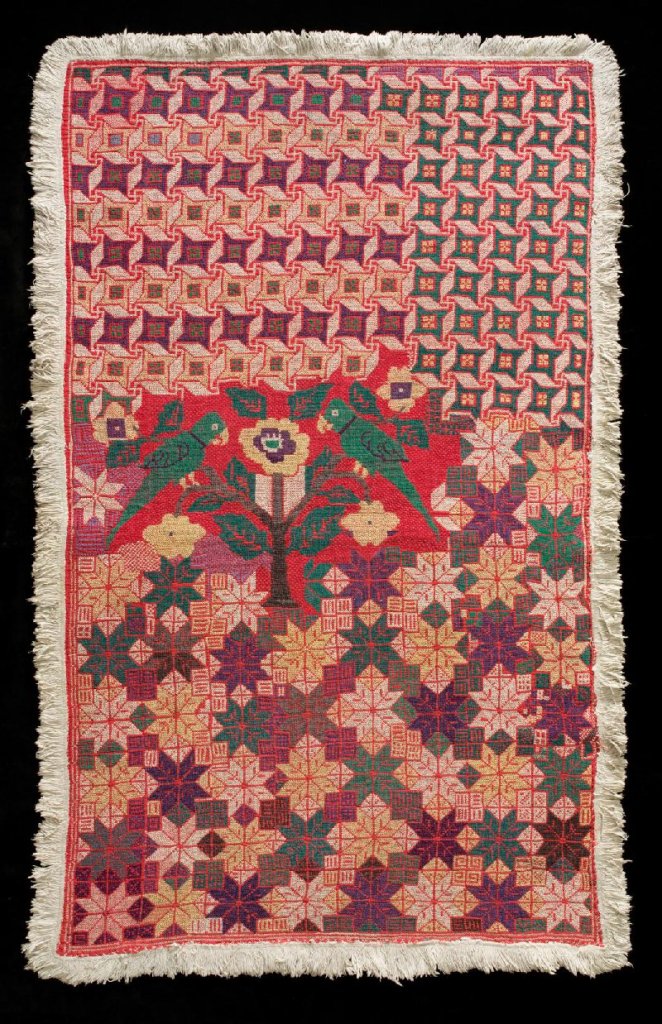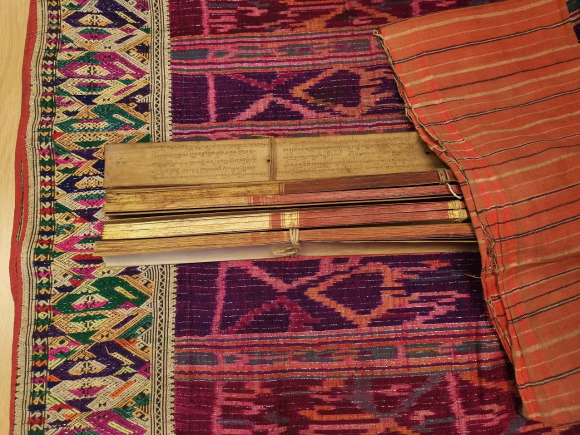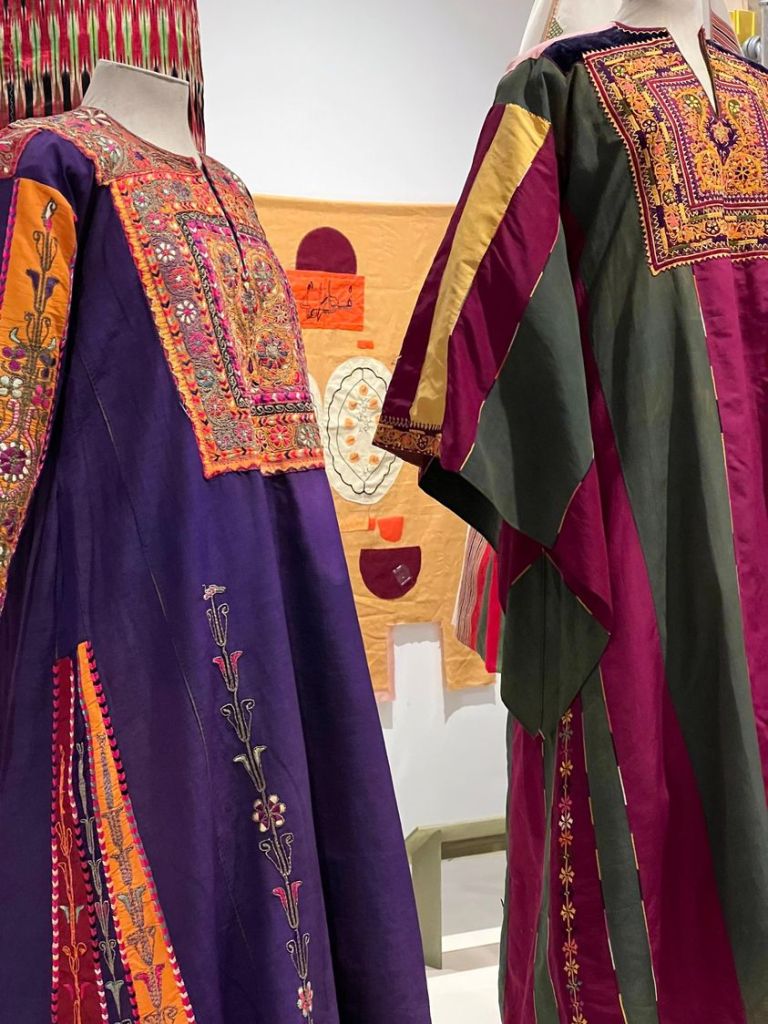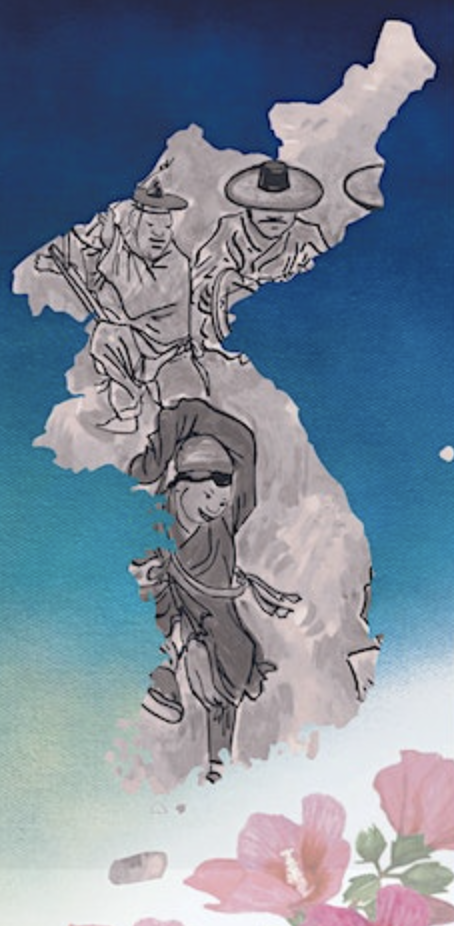
A new exhibition has opened at the Philadelphia Museum of Art, showcasing kanthas from Bengal. Entitled A Century of Kanthas: Women’s Quilts in Bengal, 1870s-1970s it runs until 01 January 2024.
“Like quilts around the world, kanthas embody thrift, labor, and imagination. Women in Bengal (modern-day Bangladesh and the state of West Bengal, India) created kanthas for a host of reasons—as ritual seating, bedcovers, baby swaddling, and much more. Most disintegrated with household use, but many that survived are now heirlooms that carry women’s individuality and love for their families across generations.
This exhibition brings into conversation two types of kanthas: nakshi (ornamented) kanthas and galicha (carpet) kanthas. The nakshi kanthas on view, from between about 1870 and 1930, are made on layers of soft, white, repurposed fabric embroidered with meaningful motifs in a delicate palette and often covered with rows of parallel white running stitches. Galicha kanthas, produced especially in the 1950s and 1960s, are thick, uniformly rectangular quilts with vivid cross-stitch embroidery in intricate geometric forms on a surface of new cloth backed by upcycled fabrics.” – Museum website.

I’m familiar with the nakshi kanthas, but have never come across the galicha type, so this has really opened my eyes.
******************************
We have a small collection of sazigyo – Burmese tablet-woven bands used to wrap around palm-leaf manuscripts – so I was very interested to read this British Library blog on the use of manuscript textiles in Thailand and Laos. It’s written and illustrated by Methaporn (Noon) Singhanan, who is a Chevening Fellow at the Library.
“Thai and Lao manuscript textiles have a rich history that dates back to at least the 18th century. Buddhist teachings and scriptures, written on palm leaves or paper, were highly valued, and often adorned with intricate designs, illustrations, and calligraphy. Manuscript textiles were created to protect and preserve these texts from dust, humidity and insects and, as a result, many were transformed into beautiful pieces.” – Methaporn Singhanan

******************************
Material Power: Palestinian Embroidery opened at Kettle’s Yard in Cambridge, UK, this week and explores the historical life and contemporary significance of Palestinian embroidery. It runs until 29 October 2023, and will also be shown in Manchester in 2024.
“Curated by Rachel Dedman, the exhibition looks at the ways in which embroidery, primarily undertaken by women, has evolved through a century of turbulent history for the Palestinian people.

This is the first major exhibition of Palestinian embroidery in the UK for over 30 years, with more than 40 dresses and embroidered objects on display lent from important private collections in Jordan and Palestine. Every dress tells a story: whether about the lives of women with their astonishing skills and creativity in the early decades of the last century, or the trauma of displacement as a result of the war of 1948. And reflecting the decades since: in which the vibrant colours and patterns of Palestinian embroidery, now often created for a global market by groups of women, have become symbolic of nationhood, memory, and resistance. Alongside historic dresses are artworks by five contemporary artists, films of embroiderers speaking about their work and rarely seen archive material.” – Kettle’s Yard website
Kettle’s Yard Director Andrew Nairne will give a free informal introduction to the exhibition on 20 July 2023 from 12:00-13:00.
******************************
OATG member Lee Talbot – curator at the George Washington Textile Museum – is giving a free online talk tomorrow Wednesday 12 July at 7pm CT. His subject is Korean Fashion from Royal Court to Runway. I’ve seen a couple of video walkthroughs of exhibitions by Lee and he is a very knowledgable and engaging speaker. Click here for more details and to register.

******************************
The next OATG event is an in-person talk in Oxford by Dr Rachel Silberstein this Thursday, 13 July. This was initially scheduled for 2020, so we are delighted we are finally able to hear her speak. Her subject is A Fashionable Century: Textile Artistry and Commerce in the Late Qing.
“This talk examines the expansion of commercialized dress and embroidery production during the late Qing period. With a focus on Suzhou, the center of fashionable dress production and embroidery, it shows how this city benefitted from the Gu embroidery trend, and how the expansion of commercial embroidery created networks of urban guilds, commercial workshops and subcontracted female workers. Though little attention was paid to these workers, objects of fashion reveal much about women’s participation—as both producers and consumers—in the commercialization of textile handicrafts. By reading objects of clothing and accessories from museum collections alongside pattern-books and advertisements, we will see how embroidery shops and accessory producers sought to brand and market their wares, and in turn, what these efforts tell us about the conflict of gender values inherent to the commercial production of dress and embroidery.” – Rachel Silberstein

As usual, this talk is free for OATG members (who should have already received their invitation), with a small charge for non-members. Click here for full details.
******************************
The Brunei Gallery at SOAS, London, will host a new exhibition from the Karun Thakar collection from 13 July to 23 September 2023. The subject of this exhibition is Japanese Aesthetics of Recycling, and it features over one hundred objects, including Boro and sakiori textiles, washi and kin-tsugi or gin-tsugi pottery.
“Boro (Japanese: ぼろ) is a class of Japanese textiles that have been mended or patched together. The term is derived from Japanese boroboro, meaning something tattered or repaired. Fashioned from worn clothing and ‘waste’ fabric to create ‘Boro’, the textile pieces have become very popular with collectors in Japan & throughout the world over the last 20 years. These pieces are often marketed as ‘abstract art’ in the Western context. They are in fact an important aspect of Japanese history and culture, showing the resilience and creativity shown by working people living in very harsh environment with very few resources.

Washi (handmade paper) was widely used in the Meiji & Showa period to make wrappings for valuable kimonos, tea storage bags, wrappers for documents as well as floor coverings and room dividers. Often old ledgers were recycled and layered to make these objects, persimmon paste was used to make them waterproof. Shifu garments will also be exhibited, these were woven using twisted and plaited paper yarn, farmers originally cut the pages of ancient account books in order to turn them into woven paper. The ink writing on the paper also remained visible in the finished fabric leaving an interesting speckled pattern.
Various examples of kin-tsugi or gin-tsugi “golden joinery” pottery will also be exhibited form The Heian period (平安時代, Heian jidai) 794 to 1185 to Edo period (江戸時代, Edo jidai) 1603 and 1867. Breakage and repairs were not disguised in these pots and were seen as rich part of the history of these objects. Yobi-tsugi pieces, which were constructed from different broken pots will also be exhibited.” – SOAS website
******************************
On 13 and 14 July a Textile Bazaar will be held at Hellens Manor near Ledbury in Herefordshire – a great chance to find a textile treasure to add to your collection. A list of exhibitors can be found here.

******************************
Another great opportunity to buy wonderful textiles comes next week on Wednesday 19th July at this pop-up sale. A great range of textiles to see for interiors, film, costume, and collectors. Sallie Ead will be there with her selection of antique European and other ethnographic textiles, John Gillow and Martin Conlan (Slow Loris) will have a fabulous selection of textiles from around the world. It runs from 1100-1800 and entry is free.

******************************
Many of you will be aware of the Textile Research Centre in Leiden, which I was lucky enough to visit a few years ago.
“The TRC is an international research hub for textiles and dress. It is a centre open to anyone who is interested and working in the field of textiles and dress, literally from students, academics, professional textile makers and designers, to the public. As a knowledge centre, the TRC is involved in both collecting a wide range of textiles, dress and accessories and in passing on knowledge about techniques and uses to the current and future generations. ” – Museum website

The TRC’s Dr Gillian Vogelsang-Eastwood is giving a talk about the work of the centre, at the Fashion and Textile Museum in London on 20 July 2023 at 14:00. Tickets cost £17.50, but do include entry to the current exhibition Andy Warhol: The Textiles. Click here for more details.
******************************
David Richardson and I will be giving a free online talk on Saturday 29 July 2023 as part of the Textile Museum’s Rug and Textile Appreciation sessions. Our subject will be Changing Women’s Fashions on the Indonesian Island of Sumba. Most textile lovers are aware of the Sumbanese men’s hip wrappers known as hinggi, but many know little about the women’s tubeskirts, known as lau. These are made using a wide variety of techniques, which we will discuss in this talk.

The talk is free, and begins at 11:00 EDT/08:00 PDT, which is 16:00 BST, and you can register for it here.
******************************
Finally, news of another textile fair. The New TRIBAL ANTIQUE & DECORATIVE TEXTILES FAIR will take place on Sunday July 30th at St Mary Abbots Centre, Vicarage Gate, W8 4HN, near Kensington Church Street, London. This is an upcoming new antique textile fair, following the demise of the Hilton Olympia Tribal Art Fair. All of the best dealers, from that event and more, will be exhibiting on July 30th. The organisers hope that this will become a destination event and will happen in June and November in subsequent years.

******************************